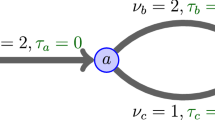Abstract
We propose an algorithm to compute the optimum departure time and path for a commuter in a congested network. Constant costs for use of arcs, cost functions of travel time depending on exogenous congestion and schedule delay are taken into account. A best path for a given departure time is computed with a previous algorithm for the generalized shortest path problem. The globally optimal departure time and an optimal path are determined by adapting Piyavskii's algorithm to the case of one-sided Lipschitz functions.
Similar content being viewed by others
References
R. Arnott, A. de Palma and R. Lindsey, Economics of a Bottleneck, J. of Urban Econ. 27 (1990) 111–130.
M.D. Atkinson, J.-R. Sack, N. Santoro and Th. Strotholte. Min-max heaps and generalized priority queues, Commun. ACM 29 (1986) 996–1000.
A. de Palma, P. Hansen and M. Labbé, Commuters' paths with penalties for early or late arrival time, Transp. Sci. (1990) forthcoming.
P. Hansen, Bicriterion path problems, in:Multiple Criteria Decision-Making: Theory and Applications, G. Fandel and T. Gall (eds.) (Springer, Berlin, 1980) pp. 109–127.
P. Hansen, B. Jaumard and S.H. Lu, Global optimization of univariate Lipschitz functions. I. Survey and properties, RUTCOR Research Report 18-89 (1989), to appear in Math. Progr.
P. Hansen, B. Jaumard and S.H. Lu, Global optimization of univariate Lipschitz functions. II. New algorithms and computational comparison, RUTCOR Research Report 23-89 (1989), to appear in Math. Progr.
C. Hendrickson and G. Kocur, Schedule delay and departure time decisions in a deterministic model, Transp. Sci. 15 (1981) 62–77.
S.A. Piyavskii, An algorithm for finding the absolute minimum of a function, Theory of Optimal Solutions, No. 2, Kiev, IK AN USSR (in Russian) (1967) 13–24.
S.A. Piyavskii, An algorithm for finding the absolute extremum of a function, USSR Comput. Maths. Math. Phys. 12 (1972) 57–67; (Zh. vychisl. Mat. mat. Fiz. 12 (1972) 888–896).
B.O. Shubert, A sequential method seeking the global maximum of a function, SIAM J. Num. Anal. 9 (1972) 379–388.
W.S. Vickrey, Congestion theory and transport investment, Amer. Econ. Rev. 59 (1969) 251–261.
Author information
Authors and Affiliations
Additional information
This research has benefited from a grant of the Transportation Center of Northwestern University. The first author's research was partially supported by NSF grant No. SES-8911517 to Northwestern University. The second author's research was partially supported by AFOSR grants No. 89-0512 and 90-0008 to Rutgers University.
Rights and permissions
About this article
Cite this article
de Palma, A., Hansen, P. Optimum departure times for commuters in congested networks. Ann Oper Res 25, 279–290 (1990). https://doi.org/10.1007/BF02283700
Issue Date:
DOI: https://doi.org/10.1007/BF02283700




